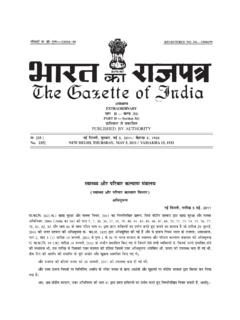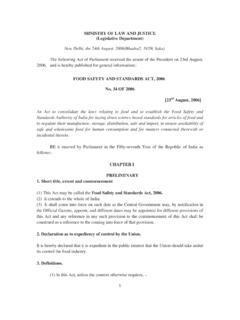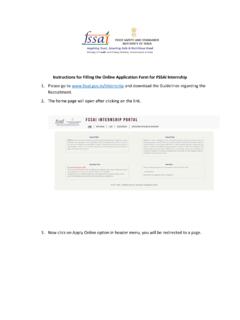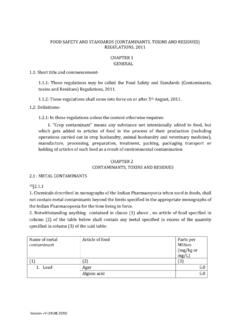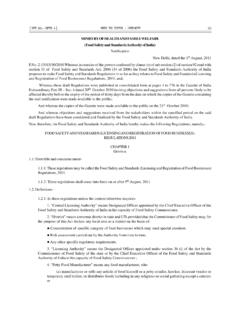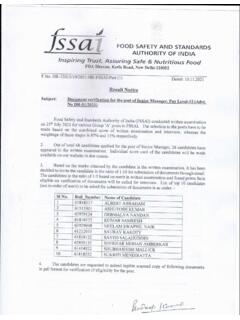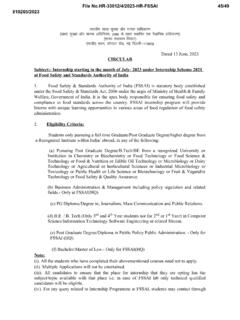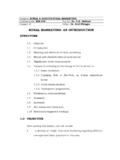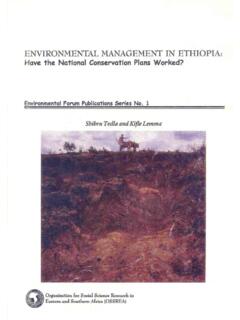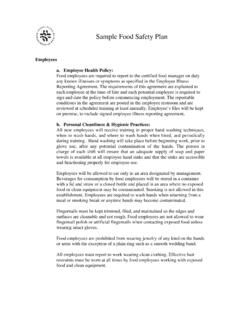Transcription of Food Safety and Standards (Advertising and Claims ...
1 Version I ( ) Food Safety and Standards (Advertising and Claims ) Regulations, 2018 1. Short title and commencement- (1) These regulations may be called the Food Safety and Standards (Advertising and Claims ) Regulations, 2018. (2) They shall come into force on the date of their publication in the Official Gazette and Food Business Operator shall comply with all the provisions of these regulations by 1st July, 2019. 2. Definitions (1) In these regulations unless the context otherwise requires,- (a) Act means the Food Safety and Standards Act, 2006 (34 of 2006); (b) advertisement means any audio or visual publicity, representation or pronouncement made by means of any light, sound, smoke, gas, print, electronic media, internet or website and includes through any notice, circular, label, wrapper, or other documents; (c) balanced diet means a diet containing all essential (macro and micro) nutrients in optimum quantities and in appropriate proportions that meet the requirements.
2 (d) claim means any representation which is printed, oral, audio or visual and states, suggests, or implies that a food has particular qualities relating to its origin, nutritional properties, nature, processing, composition or otherwise; (e) dietary fiber means carbohydrate polymers with a degree of polymerisation (DP) not lower than three, which are not hydrolysed by the endogenous enzymes in the small intestine of humans and the same consists of one or more of- (i) edible carbohydrate polymers naturally occurring in the food as consumed; (ii) carbohydrate polymers, which have been obtained from food raw material by physical, enzymatic or chemical means; (iii) synthetic carbohydrate polymers; (f) equivalence Claims means Claims that attempt to promote the equality in value, amount and importance of one food attribute to another; (g) fat means total lipids including saturated fat, monounsaturated fat, polyunsaturated fat and trans fat.
3 For the purposes of this clause,- (i) saturated fats means fatty acids without double bonds; (ii) monounsaturated fats means fatty acids with one cis double bond; (iii) polyunsaturated fats means fatty acids with cis-cis methylene interrupted double bonds; and (iv) trans fat means all the geometrical isomers of monounsaturated and polyunsaturated fatty acids having non-conjugated, interrupted by at least one methylene group, carbon-carbon double bonds in the trans configuration; (h) health claim means any representation that states, suggests, or implies that a relationship exists between a food or a constituent of that food and health, which includes the following, namely:- (i) nutrient function claim is that which describes the physiological role of the nutrient in growth, development and normal functions of the body; Example: Nutrient A - naming a physiological role of nutrient A in the body in maintenance of health and promotion of normal growth and development.
4 (Food X is a rich source of or high in nutrient A ); (ii) other function claim that describes the specific beneficial effects of the consumption of foods or their constituents, in the context of the total diet or normal functions or biological activities of the body, which relate to a positive contribution to health or to the improvement of a function or to modifying or preserving health. Example: Substance A naming the effect of substance A on improving or modifying physiological function or biological activity, associated with health (Food Y contains X grams of substance A ).
5 ; Version I ( ) (iii) reduction of disease risk Claims refers to Claims that state, suggest or imply that consumption of such foods or food constituents, in the context of total diet, reduce the risk of developing a disease or health related condition. for the purpose of this sub-clause, reduction of disease risk means significantly altering major risk factors, for a disease or health related condition as diseases have multiple risk factors and altering one of these risk factors may or may not have a beneficial effect and the presentation of risk reduction claim must ensure, for example, by use of appropriate language and reference to other risk factors, that consumers do not interpret them as prevention Claims .
6 Examples: (a) A healthful diet low in nutrient or substance A may reduce the risk of disease D. Food X is low in nutrient or substance A ; (b) A healthful diet rich in nutrient or substance A may reduce the risk of disease D. Food X is rich in nutrient or substance A ; (i) marketer refers to persons or companies, including advertisers, and direct marketers, including e-platforms who or on whose behalf marketing communications are published for the purpose of promoting their products or influencing consumer behaviour; (j) marketing communications includes advertising as well as other techniques, such as promotions, sponsorships and direct marketing, and shall be interpreted broadly to mean any communications produced directly by or on behalf of marketers intended primarily to promote products or to influence consumer behaviour; (k) nutrient means a constituent of food, which- (i) provides energy ; or (ii) has specific metabolic or physiological functions; or (iii) is needed for growth and development and maintenance of healthy life.
7 (l) nutrition claim means any representation which states, suggests or implies that a food has particular nutritional properties including but not limited to the energy value and to the content of protein, fat and carbohydrates, as well as the content of vitamins, minerals and other permitted listed nutrients and nutrition Claims may include the following: (i) nutrient content claim is a nutrition claim that directly or indirectly describes the level of a nutrient contained in a food. (Examples: contains or source of; high in; rich in; low in, etc.); (ii) nutrient comparative claim is a claim that compares the nutrient levels or energy value of two or more foods.
8 (Examples: reduced; less than; fewer; increased; more than, etc.); (m) non-addition claim means any claim that an ingredient or additive has not been added to a food, either directly or indirectly and the ingredient or additive is one whose presence or addition is permitted in the food and which consumers would normally expect to find in the food; (n) recommended dietary allowances means the average daily dietary nutrient intake level sufficient to meet the nutrient requirement of nearly all (97 to 98 per cent.) healthy individuals in a particular life stage and gender group.
9 For the purposes of this clause, recommended dietary allowances values as provided in current Indian Council of Medical Research Nutrient Requirements and Recommended Dietary Allowances for Indians shall be applicable and if Indian recommended dietary allowances is not available for any nutrient then values provided in Codex or World Health Organization guidelines shall be applicable; (o) sugars means all monosaccharides (glucose, fructose, etc.) and disaccharides (maltose, sucrose, lactose, etc.). (2) All other words and expressions used herein and not defined, but defined in the Act, rules or regulations made thereunder, shall have the meanings assigned to them in the Act, rules or regulations, respectively.
10 Version I ( ) 3. Food business operator and marketers to follow general Every food business operator and marketer while advertising and publishing or disseminating marketing communication meant for promotion or sale of any article of food including labelling Claims shall comply with the following general principles: Provided that advertisements and Claims in respect of food meant for infants shall be in accordance with the Infant Milk Substitutes, Feeding Bottles and Infant Foods (Regulation of Production, Supply and Distribution) Act, 1992 (41 of 1992) Act).
